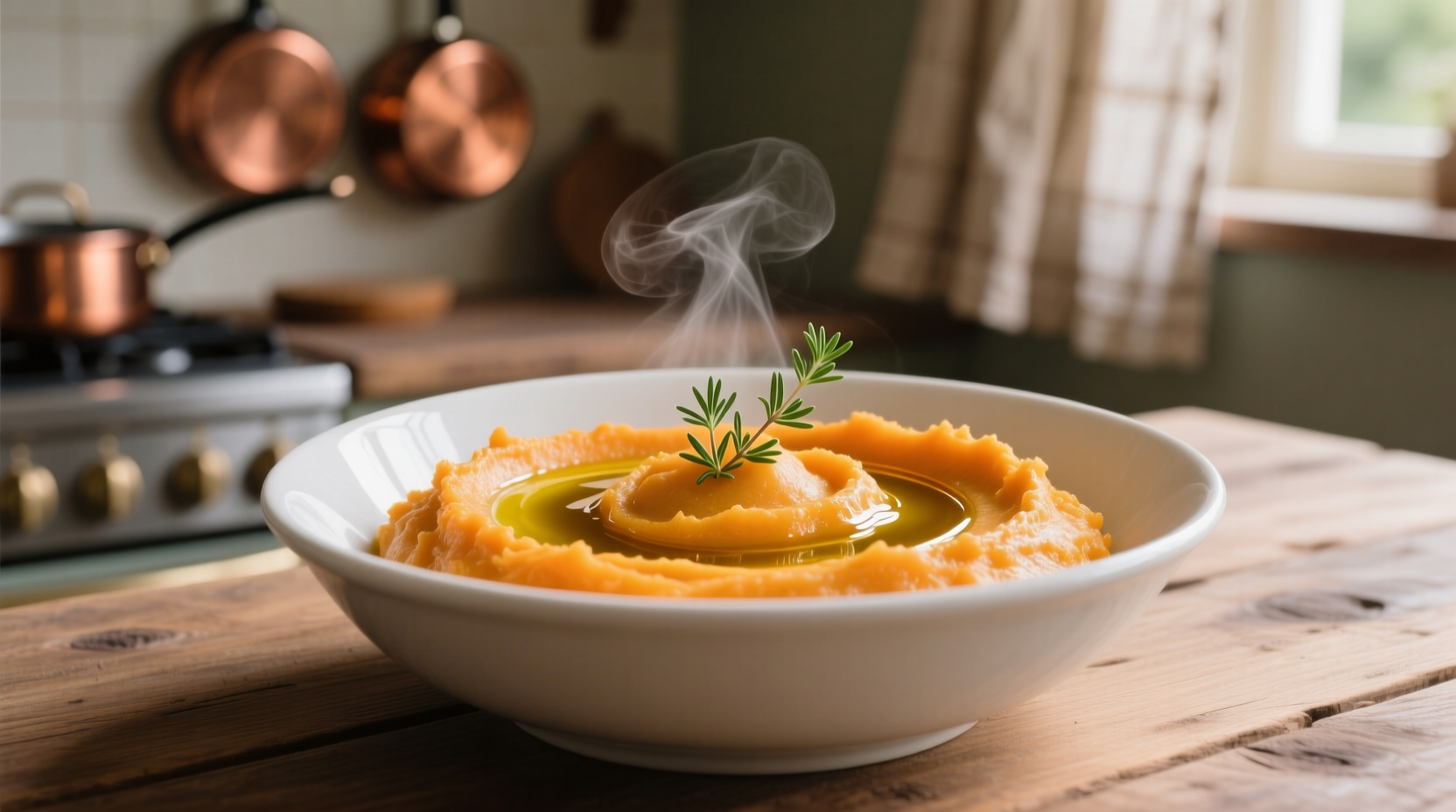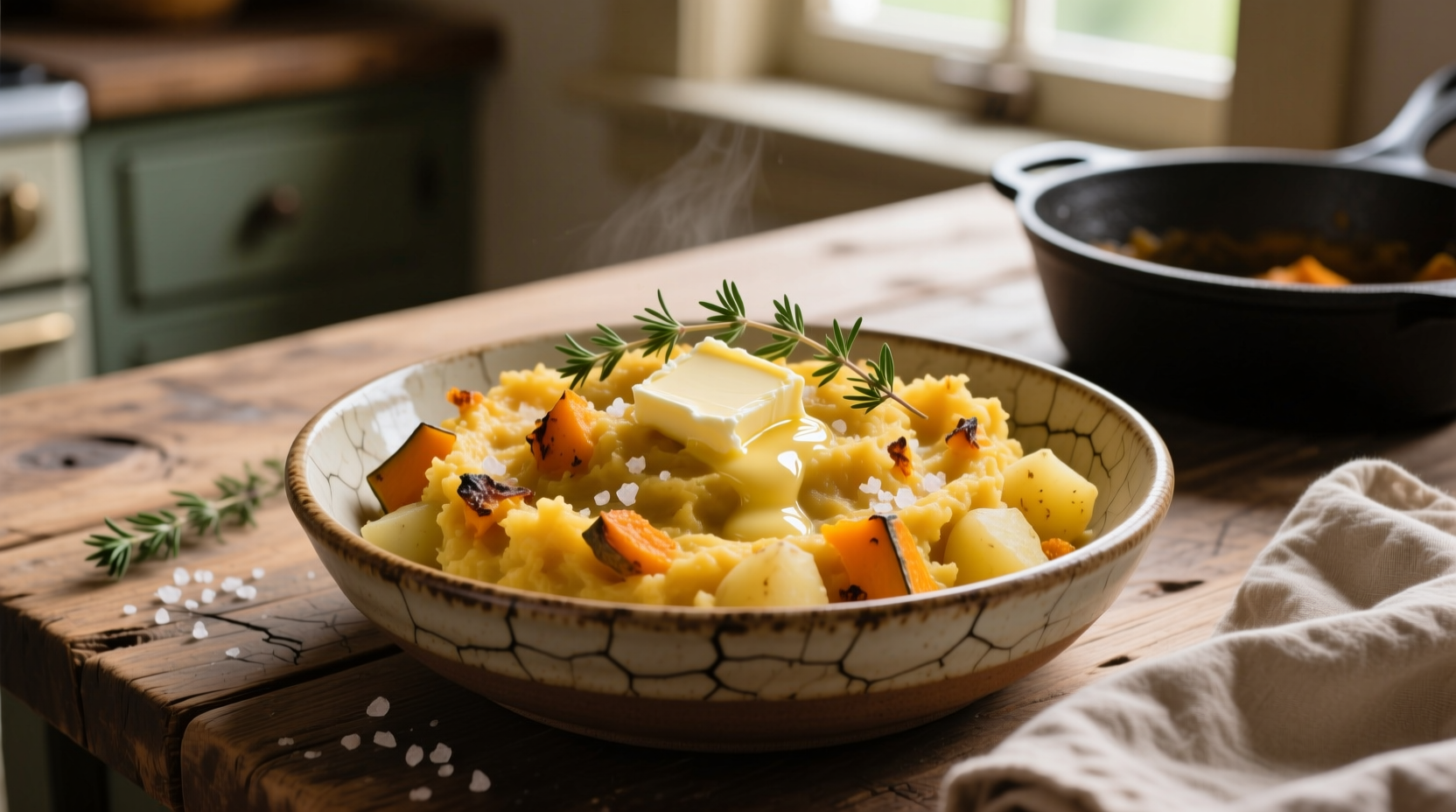Understanding Squash and Potato Mash Fundamentals
When deciding between squash mash and potato mash for your next meal, understanding their core characteristics is essential. Both preparations transform humble ingredients into comforting side dishes, but their culinary applications differ significantly. Potato mash has been a staple in Western cuisine for centuries, while squash mash has gained popularity as home cooks seek more nutrient-dense alternatives.
Nutritional Comparison: Health Benefits Breakdown
From a nutritional standpoint, squash mash generally outperforms potato mash in vitamin content. Butternut squash, commonly used for mashing, contains significantly more vitamin A and vitamin C than white potatoes. This difference stems from squash's vibrant orange color, indicating high beta-carotene content.
| Nutrient (per 100g) | Butternut Squash Mash | Potato Mash (Yukon Gold) |
|---|---|---|
| Calories | 45 kcal | 75 kcal |
| Vitamin A | 14,882 IU (298% DV) | 2 IU (0% DV) |
| Vitamin C | 31 mg (52% DV) | 12 mg (20% DV) |
| Dietary Fiber | 2 g | 1.6 g |
| Glycemic Index | 51 (Medium) | 78 (High) |
Source: USDA FoodData Central (2023). This nutritional comparison shows why health-conscious cooks often choose squash mash as a nutrient-dense alternative to traditional potato preparations.
Texture and Flavor Profiles Compared
Texture determines how these mashes perform in different culinary contexts. Potato mash delivers that familiar, fluffy consistency that's become the gold standard for comfort food. The starch content in potatoes creates that signature pillowy texture when properly prepared. Squash mash, by contrast, offers a smoother, silkier mouthfeel with natural sweetness that varies by squash variety.
Professional chefs note that butternut squash provides the best balance for mashing - sweet but not overpowering, with a texture that holds up well. Acorn squash creates a denser mash, while delicata squash offers more pronounced sweetness. For potato mash, Yukon Gold varieties consistently produce superior results compared to Russets, which can become gluey if overworked.

Optimal Preparation Techniques
Mastering the preparation process makes all the difference in achieving perfect results. For potato mash, the key is controlling moisture content. Chefs recommend steaming potatoes rather than boiling to prevent water absorption. After cooking, pass potatoes through a ricer while still warm, then gradually incorporate warm dairy while folding gently to avoid activating excess starch.
Squash mash preparation follows different principles. Roasting squash before mashing develops deeper flavor through caramelization. Cut squash in half, remove seeds, and roast cut-side down at 400°F until tender. Scoop out flesh and process through a food mill for ultra-smooth results. Unlike potatoes, squash contains less starch, so achieving creaminess requires strategic fat incorporation.
When to Choose Each Preparation
Understanding context boundaries helps you select the right mash for each occasion. Potato mash remains the classic choice for traditional holiday meals and steakhouse-style accompaniments. Its neutral flavor profile makes it the perfect canvas for rich gravies and buttery additions. Squash mash shines in autumn menus, pairing beautifully with poultry, pork, and game meats.
Consider these specific scenarios:
- Thanksgiving dinner: Use potato mash for traditional appeal, but consider a butternut squash-potato blend for added nutrition and color
- Weeknight family meal: Potato mash offers quicker preparation with familiar flavors kids enjoy
- Special diet needs: Squash mash provides lower glycemic impact for blood sugar management
- Fall entertaining: Vibrant orange squash mash creates visual appeal on the plate
Avoiding Common Preparation Mistakes
Even experienced cooks make critical errors when preparing these mashes. For potato mash, the most frequent mistake is overmixing, which releases too much starch and creates a gummy texture. Always use a potato masher or ricer rather than a food processor for best results.
With squash mash, inadequate moisture control presents the biggest challenge. Squash contains more water than potatoes, so improper draining leads to watery results. Professional chefs recommend spreading cooked squash on paper towels to absorb excess moisture before mashing. Additionally, adding cold dairy to hot squash causes separation - always warm your cream or butter first.
Historical Evolution of Mashed Preparations
Mashed potatoes entered European cuisine after potatoes were brought from South America in the 16th century, but didn't become widespread until the 18th century. The first recorded mashed potato recipe appeared in 1747 in Hannah Glasse's The Art of Cookery Made Plain and Easy. Squash varieties have been cultivated in North America for over 5,000 years, but squash mash as we know it developed more recently as home cooks sought alternatives to traditional potato preparations.
According to culinary historians at the Oxford Symposium on Food and Cookery, the modern interest in squash mash correlates with the farm-to-table movement's emphasis on seasonal, locally-sourced ingredients. This shift represents a broader trend toward rediscovering heritage ingredients with superior nutritional profiles.
Expert Recipe Variations Worth Trying
Once you've mastered the basics, experiment with these professional variations that elevate both preparations:
Potato Mash Enhancements
- Garlic confit mash: Infuse olive oil with whole garlic cloves at low temperature, then blend the softened garlic into your mash
- Horseradish whip: Incorporate freshly grated horseradish for a spicy kick that cuts through rich meats
- Truffle parmesan: Add a small amount of truffle oil and freshly grated parmesan for elegant flavor
Squash Mash Innovations
- Sage brown butter squash: Finish with browned butter and fresh sage for autumnal depth
- Curried coconut squash: Blend in coconut milk and mild curry powder for exotic flair
- Maple roasted garlic: Add pure maple syrup and roasted garlic for sophisticated sweetness
Final Recommendations for Perfect Results
Whether you're preparing a weeknight dinner or holiday feast, understanding the distinct qualities of squash and potato mash helps you make informed choices. Potato mash remains the versatile classic that satisfies traditional expectations, while squash mash offers nutritional advantages and seasonal appeal. For best results, match your mash selection to the main course, occasion, and dietary needs of your guests.
Consider blending both for the ultimate compromise - a potato-squash hybrid delivers the familiar texture of potatoes with the nutritional boost and subtle sweetness of squash. This approach satisfies diverse palates while maximizing health benefits, making it an excellent choice for family gatherings where accommodating different preferences matters.











 浙公网安备
33010002000092号
浙公网安备
33010002000092号 浙B2-20120091-4
浙B2-20120091-4